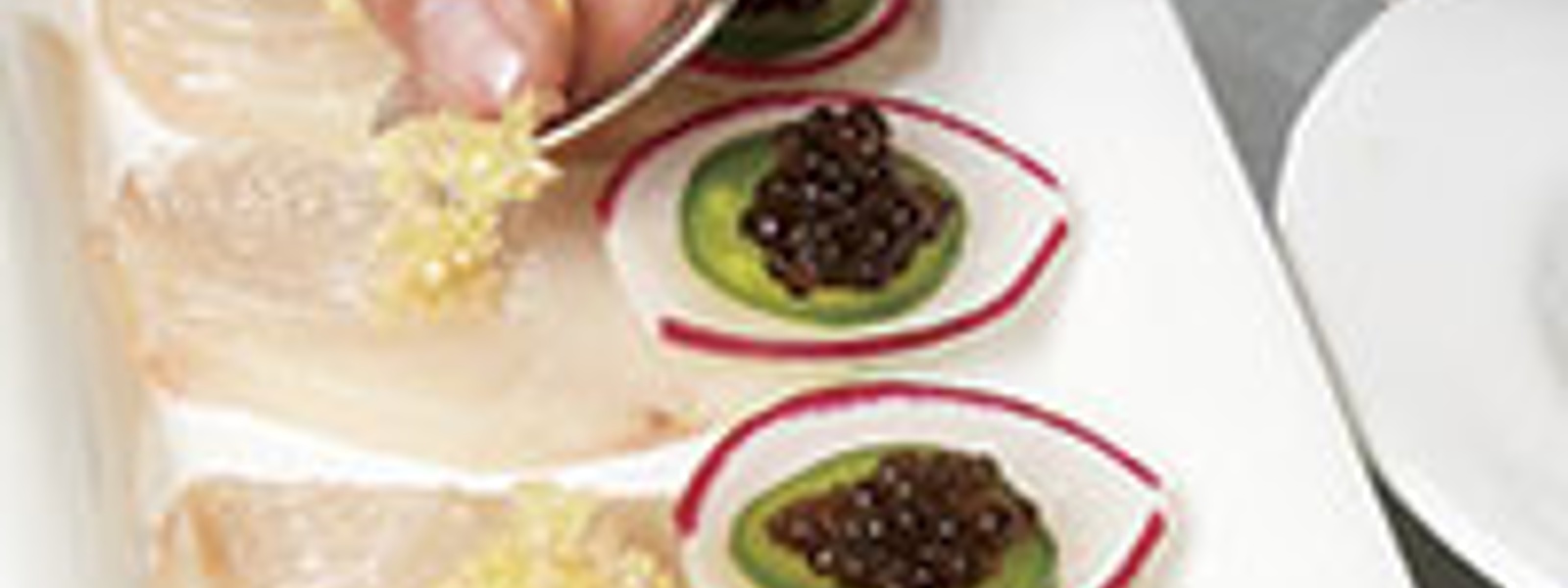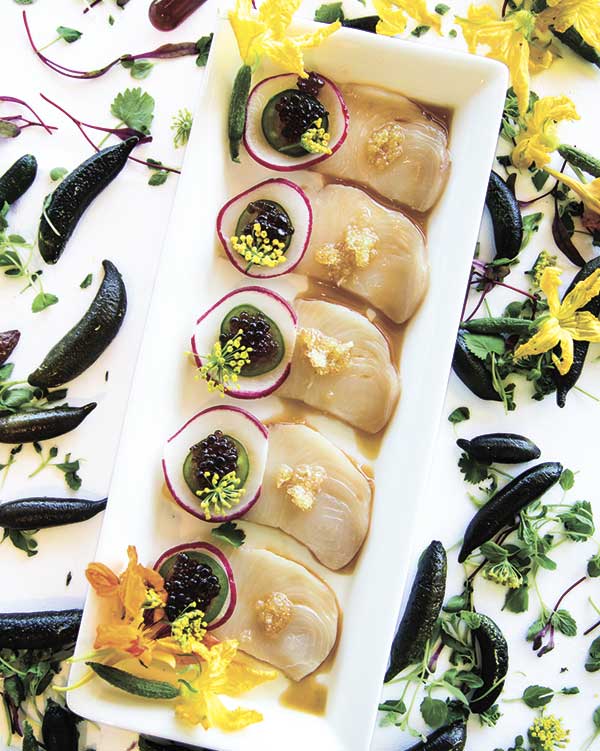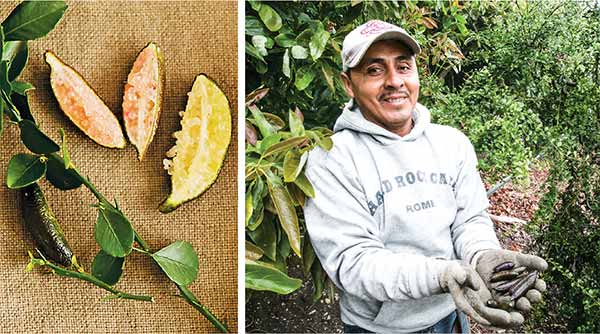The caviar of citrus


The citrus flavor of finger limes pairs well with many food and drink recipes, especially seafood dishes such as this hamachi tiradito. Photo: © 2017 Richard Green
It's an adage that perhaps rings most true for the finger lime, but farmer Jim Shanley hopes people "don't judge a book by its cover" when they encounter the unusual citrus fruit.
Small and cylindrical, just a few inches long and often green, a finger lime looks much like a jalapeño or small pickle. But its appearance is deceiving.
Once cut, the fruit reveals tiny, caviar-like pearls that lend to its alternative name of caviar lime. Tart, fresh and filled with juice, the pearls burst with lemon, lime and grapefruit flavors—a stark contrast to the spicy or sour taste one might expect.
"I say God gave me a wonderful marketing opportunity in a horrible package," Shanley said with a laugh.
Shanley's introduction to the finger lime came in 2004, when he attended a citrus exhibition hosted by a group of University of California, Riverside, researchers. Native to Australia, the fruit wasn't grown commercially in the U.S. at the time, but Shanley, who took up farming in 1998, was intrigued by its potential.
"My reaction was, 'That is the coolest thing I've ever seen,'" he recalled. "I thought, 'I want that right now and I know where I'm going to plant it.'"
And off he went. Shanley bought and planted finger lime trees on ranches in Morro Bay and the Visalia area in 2006, making him the first U.S. farmer to commercially plant the crop and solidifying California as the epicenter of the fledgling domestic business.

Finger limes grow on trees and may look like jalapeños, but Jim Shanley, left, and daughter Megan Shanley Warren say the firm, caviar-like pearls inside the fruit release a refreshing burst of citrus juices when eaten. Photos: © 2017 Richard Green
Although native finger limes were originally found in a subtropical rainforest area, the trees have acclimated well to California's Mediterranean climate and do best along the Central Coast and in the San Joaquin Valley, where hard-frost days are limited.
By 2011, Shanley and a handful of other California farmers were ready to ship the finger limes they'd grown. That's when they discovered that learning to grow the crop was one feat, but getting people to buy the odd-looking fruit was quite another.
"When you look at it, it's not something you would associate at all with citrus," Shanley said.
So he and his daughter, Megan Shanley Warren, who directs sales and marketing for family-owned Shanley Farms, have had to marry the roles of farmer and educator.
"The majority of shoppers have never heard of finger limes," Shanley Warren said, adding that the farm works to show people how to incorporate the finger lime into everyday cooking. "It goes well with seafood dishes, cocktails, yogurts and ice creams, tarts, so many dishes. It's so versatile."

Executive Chef Benjamin Brown of Stillwater Bar & Grill credits the recipe for hamachi tiradito with being one of the simplest to execute, but its vibrant flavor and the juicy pop of the finger limes makes it a fan favorite. Photo: © 2017 Richard Green
Exploding with flavor
The finger lime's versatility is one attribute that inspires chefs such as Benjamin Brown of Stillwater Bar & Grill in Pebble Beach.
"I love having them around," he said. "There's always an application for them."
Brown credits the finger lime with providing a "bright, acidic, perfumey juice" to his creations and has folded the caviar-like pearls into dressings and dips. He also pairs them with actual caviar, and drops the pearls into cocktails and glasses of champagne.
Brown says finger limes perform best when served in cold, fresh dishes. A customer favorite at Stillwater Bar & Grill is hamachi tiradito, a ceviche-like medley of raw tuna, jalapeño and radish punctuated by the flavorful pop of finger limes. Because the pearls are firm, they release their juices in a tiny explosion.
"When you're eating whatever they are in, they are the last thing on the palate," Brown said. "It's a last pop—and a pleasant surprise."
That pop is a distinctive characteristic that Shanley appreciates as well, likening the sensation to eating Pop Rocks carbonated candy.
"It's an incredible element," he said. "It's a real pop in your mouth that gives a unique aspect to the finger lime and whatever it is used in."

With a harvest season that runs from mid-summer to late winter, the fresh taste of finger limes can be enjoyed most of the year. Shanley Farms employee Mario Cervantes shows off the fruit, which is native to Australia but is now grown in some parts of California. Photo left: courtesy Shanley Farms. Photo right: © 2017 Richard Green
Forging a new path
"Unique" is what Shanley says he has always sought—and the product niche he tries to fill as a farmer. In addition to finger limes, Shanley Farms grows and markets crops such as passionfruit, coffee beans, dragon fruit, gogi berries, raspberry figs and gator egg avocados (a smaller size that allows for the whole fruit to be eaten in a single serving).
"We're the company that wants to make food that's a bit cooler, the space a bit different," said Shanley, who previously managed a commodity trading and animal-feed manufacturing company.
Shanley Farms has partnered with grocery stores such as Whole Foods to introduce shoppers to finger limes. The farm also features recipes on its website to encourage people to have fun with finger limes in their own kitchens, although Shanley notes the fruit is easy to enjoy even on the go.
"One of the simplest ways to eat finger limes is squeezed into coconut yogurt," he said. "When you do, it tastes almost like you're eating a piña colada Pop Rocks."
The fruit's long harvest season—from June to January—means finger limes are available much of the year. During harvest, the Shanleys pick fruit from their 4,000 trees weekly to ship to stores, restaurants and online buyers.
In an effort to extend the season and perhaps overcome the misleading appearance of the fruit, the family has also begun selling just the pearls of the finger lime in jars—similar to other convenience products such as pre-washed garlic cloves or pomegranate seeds. The Shanleys say they hope this will help shoppers more easily discover the fruit's potential.
"There has been a lot of hard work in having the finger lime go from an unknown to a known," Shanley said. "But once people eat it, once they taste it, we have a customer who loves what this fruit is and the great flavors it can provide."

